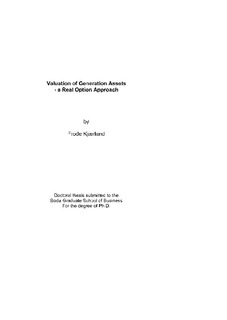Valuation of generation assets : a real option approach
Original version
Kjærland, F. (2009). Valuation of generation assets: a real option approach (Doctoral thesis). Bodø Graduate School of BusinessAbstract
Chapter 3: The discussion contributes to the general discussion regarding the seldom use of real option by practitioners. The study offers explanations rooted in different scientific paradigms to explain the limited use of real options in business practices. In addition, the discussion provides recommendations concerning when and how a real option approach may prove beneficial for businesses in their capital budgeting and valuation analyses.
Chapter 4: This chapter addresses the ambitious task of attempting to explain the value of generating companies in this complex industry. The models presented, based on unique data, provide insight into understanding value and value components of electric utilities. Despite some disputable factors, the results do support real options as contributing to value explanation. Hence, this empirical study contributes to the literature on real option applications.
Chapter 5: The analysis demonstrates an approach for calculating the value of hydropower investment opportunities as well as optimal trigger price for initiating such an investment. The chapter provides evidence of consistency between real option theory and aggregate investment behaviour and offers a trustworthy level of the forward electricity price as trigger for an investment.
Chapter 6: This study calculates the switching option values of operational flexibility gained when adding nuclear, coal fired and gas fired power plants to a mainly hydro based operator restricted by long term industry contracts. By switching to thermal in some parts of the year the operator is able to save more water in magazine reservoirs for peak price periods. The switching option value is highest for nuclear and lowest for gas fired thermal generation. If thermal capacity is rented from another operator the option value is depending on the agreed price. Hence, from the viewpoint of flexibility, the least profitable alternative is gas-fired thermal generation – paradoxically the only thermal generation actually implemented in the Norwegian power system. The study shows that option values may in some situations be significant and should be taken into consideration either 1) in assessment of own thermal investments, or 2) in negotiations with thermal operators of option contracts. The results can also to a certain extent be applied for justifying Governmental subsidies at system level.
Description
Doctoral thesis (Ph.D.) – Bodø Graduate School of Business, 2009
